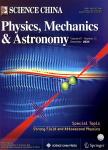Observation of signature inversion in the πh_(9/2)(×)νi_(13/2) oblate band
Observation of signature inversion in the πh_(9/2)νi_(13/2) oblate band作者机构:1. Institute of Modern Physics Chinese Academy of Sciences 730000 Lanzhou China 2. Graduate School of the Chinese Academy of Sciences 100049 Beijing China 3. Institute of Atomic Energy Research 102413 Beijing China
出 版 物:《Science China(Physics,Mechanics & Astronomy)》 (中国科学:物理学、力学、天文学(英文版))
年 卷 期:2005年第48卷第4期
页 面:442-449页
核心收录:
学科分类:08[工学] 0827[工学-核科学与技术] 082701[工学-核能科学与工程]
基 金:supported by the National Natural Science Foundation of China(Grant Nos.10475097,10375077 and 10221003) the Major State Basic Research Development Program of China(Grant No.G2000077402)and the Chinese Academy of Sciences
主 题:deformed odd-odd 190Tl, oblate rotational bands, signature inversion, 2-qp+rotor model.
摘 要:High-spin states in 190Tl have been studied via the 160Gd(35Cl, 5nγ) reaction. The level scheme, consisting of the π h9 /2 νi13/2 oblate band and a cascade with character of single particle excitations, has been established. Spin values have been firmly assigned to the oblate band in 190Tl, resulting in low-spin signature inversion in the π h9 /2 νi13/2 oblate band for the first time. Based on the similarity of the level structure in doubly odd Tl nuclei, spin values for the oblate bands in 192―200Tl should be re-assigned, and a consistent low-spin signature inversion has occurred in these oblate deformed nuclei. The low-spin signature inversion phenomena can be interpreted qualitatively by using the 2-quasiparticle plus rotor model including p-n residual interactions.



